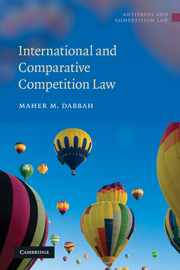Book contents
- Frontmatter
- Contents
- Preface
- List of abbreviations
- Table of Cases
- Table of Statutes
- Table of Regulations
- 1 Introduction
- 2 The internationalisation of competition law: concepts, ideas, options and players
- 3 The involvement of international bodies and organisations in the field of competition law and policy
- 4 EU competition law regime
- 5 US competition law regime
- 6 Competition law and policy in developing countries
- 7 Regional competition law and policy
- 8 The unilateral option: extraterritorial assertion of jurisdiction
- 9 The bilateral option: cooperation between competition authorities
- 10 The multilateral option: cooperation through binding and non-binding commitments
- 11 Competition and trade policy
- Bibliography
- Index
10 - The multilateral option: cooperation through binding and non-binding commitments
Published online by Cambridge University Press: 05 June 2012
- Frontmatter
- Contents
- Preface
- List of abbreviations
- Table of Cases
- Table of Statutes
- Table of Regulations
- 1 Introduction
- 2 The internationalisation of competition law: concepts, ideas, options and players
- 3 The involvement of international bodies and organisations in the field of competition law and policy
- 4 EU competition law regime
- 5 US competition law regime
- 6 Competition law and policy in developing countries
- 7 Regional competition law and policy
- 8 The unilateral option: extraterritorial assertion of jurisdiction
- 9 The bilateral option: cooperation between competition authorities
- 10 The multilateral option: cooperation through binding and non-binding commitments
- 11 Competition and trade policy
- Bibliography
- Index
Summary
This chapter will examine the third of the three internationalisation options in the field of competition law: the multilateral option, namely the desire and efforts to develop a collective approach by countries in the field. The focus in the chapter will be on specific forms which this option can take and which may be conveniently grouped together under two headings: ‘binding’ obligations and ‘non-binding’ obligations. The main forms of the former – as they have come to emerge over the years – include: concluding a binding multilateral agreement; drafting an international competition law code; and building an international competition law regime with an independent institutional apparatus and capabilities and competence to handle competition cases. The latter heading, on the other hand, covers multilateral instruments introduced within a loose institutional framework, extending to mainly but not exhaustively guidelines, best practices and recommendations produced at a supranational level, i.e. by international organisations active in the field; the International Competition Network (ICN), the Organisation for Economic Cooperation and Development (OECD) and the United Nations Conference on Trade and Development (UNCTAD) have all developed and produced such instruments over the years.
The chapter will in particular shed light on the usefulness of the multilateral option as a means to address competition problems in the global economy, and assess the realistic future prospects of pursuing this option through binding and non-binding obligations on countries and highlight the difficulties surrounding each of these two endeavours.
- Type
- Chapter
- Information
- International and Comparative Competition Law , pp. 541 - 578Publisher: Cambridge University PressPrint publication year: 2010



